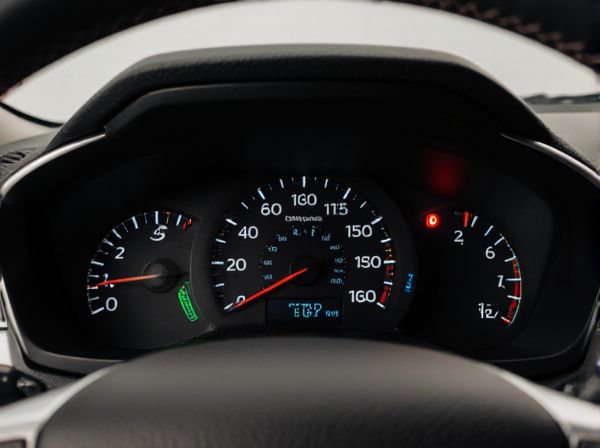
Photo illustration: Tachometer vs Shift Light Indicator
A tachometer displays your engine's RPM, giving you precise feedback on engine speed to optimize performance and prevent damage. A shift light indicator signals the ideal time to change gears, improving acceleration and fuel efficiency without you needing to monitor RPM closely. Combining both can enhance driving by providing real-time RPM data and timely shift alerts for your vehicle.
Table of Comparison
| Feature | Tachometer | Shift Light Indicator |
|---|---|---|
| Function | Displays engine RPM in real-time | Signals optimal shift point via light |
| Type | Analog or digital gauge | Visual indicator light |
| Purpose | Helps monitor engine speed for performance | Prevents engine damage, improves fuel efficiency |
| User Interaction | Continuous monitoring required | Alerts driver when shifting is recommended |
| Visibility | Always visible on dashboard | Activates only at set RPM thresholds |
Introduction to Tachometers and Shift Light Indicators
Tachometers measure engine RPM (revolutions per minute) to provide real-time feedback on engine speed, essential for optimizing performance and preventing over-revving. Shift light indicators use pre-programmed RPM thresholds to alert drivers when to shift gears, enhancing efficiency and preventing engine damage. Both devices play critical roles in high-performance and daily driving by monitoring and signaling optimal engine operation.
Defining a Tachometer: Purpose and Function
A tachometer is an essential automotive instrument that measures engine RPM (revolutions per minute) to help drivers monitor engine performance and prevent over-revving. It provides real-time data on engine speed, enabling precise gear shifts and optimizing fuel efficiency and engine longevity. Unlike a shift light indicator, which signals the optimal point to change gears, a tachometer offers continuous RPM feedback for more informed driving decisions.
What is a Shift Light Indicator?
A Shift Light Indicator is a visual device installed on a vehicle's dashboard that signals the optimal time to shift gears for maximum performance and fuel efficiency. Unlike a tachometer, which displays real-time engine RPM, the shift light triggers at a preset RPM threshold to help drivers avoid engine over-revving and improve acceleration timing. This tool is commonly used in racing and performance driving to enhance gear-shifting precision and vehicle responsiveness.
Key Differences Between Tachometers and Shift Light Indicators
Tachometers measure and display engine RPM, providing real-time feedback on engine speed to help drivers optimize performance and prevent over-revving. Shift light indicators, on the other hand, are visual cues that signal the optimal time to shift gears based on preset RPM thresholds, enhancing shift timing and improving fuel efficiency or acceleration. While tachometers offer continuous monitoring, shift lights serve as specific alerts for gear changes during driving or racing conditions.
Advantages of Using a Tachometer
A tachometer provides precise real-time engine RPM readings, allowing drivers to optimize gear changes for improved performance and fuel efficiency. Unlike shift light indicators that offer only binary signals, tachometers deliver continuous feedback, enabling better engine management during various driving conditions. This detailed RPM data helps prevent engine damage by ensuring shifts occur within safe operating ranges.
Benefits of a Shift Light Indicator
A Shift Light Indicator enhances driving performance by providing a clear, visual cue to shift gears at the optimal RPM, reducing engine strain and improving fuel efficiency. This indicator helps drivers maintain peak engine power and prevents over-revving, thus extending the engine's lifespan. Unlike a tachometer, which constantly requires the driver's attention, a shift light allows for quicker, safer gear changes by minimizing distraction.
Applications in Automotive Performance
Tachometers provide real-time engine RPM data essential for precise gear shifting and optimizing engine performance in high-performance vehicles. Shift light indicators enhance driver awareness by signaling the ideal shift points, reducing reaction time and promoting efficient power delivery during racing or spirited driving. Both devices play critical roles in maximizing vehicle acceleration, fuel efficiency, and overall drivability in motorsports and performance automotive applications.
Choosing the Right Device for Your Vehicle
Selecting the right device for your vehicle depends on your driving needs and performance goals; a tachometer provides precise RPM monitoring essential for engine health and tuning, while a shift light indicator offers a visual cue for optimal gear changes, enhancing shift timing and fuel efficiency. Sports car drivers and racers often prefer shift light indicators to maximize acceleration and minimize shift delays, whereas daily drivers and mechanics benefit from tachometers for comprehensive engine feedback. Evaluate your vehicle type, driving style, and desired level of control to determine whether a tachometer, shift light indicator, or a combination of both best suits your setup.
Installation and Calibration Tips
Tachometer installation requires securely mounting the sensor on the engine block or wiring it to the ignition coil for accurate RPM readings, while ensuring proper grounding to avoid signal interference; calibration involves setting the correct number of cylinders and ignition type in the tachometer settings. Shift light indicators should be installed within the driver's line of sight, commonly on the dashboard, and wired to the tachometer or ECU to trigger at pre-set RPM thresholds; calibration includes adjusting the trigger points to match the optimal shift RPM for the specific engine and driving conditions. Proper installation and calibration of both devices improve engine performance monitoring and shift timing precision for enhanced driving efficiency.
Conclusion: Which Suits Your Driving Needs?
A tachometer provides precise RPM data crucial for performance driving and engine health monitoring, while a shift light indicator offers a simple, visual cue ideal for quick gear changes in racing scenarios. Drivers seeking detailed engine feedback and control benefit from a tachometer, whereas those prioritizing ease of use and shift timing prefer shift light indicators. Choosing between them depends on whether accuracy or simplicity better aligns with your driving style and requirements.
 caratoz.com
caratoz.com